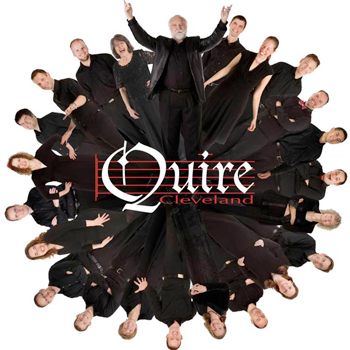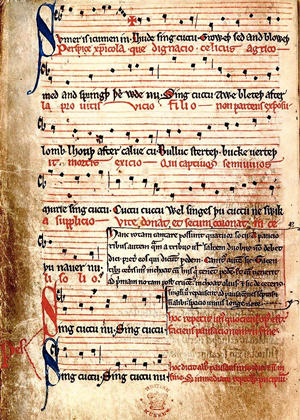by Daniel Hathaway

“Sing You After Me: Wondrous Canons” will be presented on Friday, November 7 at 7:30 pm at St. John’s Cathedral in downtown Cleveland, and repeated on Sunday, November 8 at 4:00 pm at Painesville United Methodist Church. A freewill offering will be received at both events.
Ross W. Duffin is Quire’s founder and artistic director, but his day job is practicing the art and science of musicology at Case Western Reserve University — a discipline which has put him in touch with such famous examples of canons as Sumer is icumen in (pictured below) and the elaborate experiments of such 15th-century composers as Jean Ockeghem. In a telephone conversation, Duffin noted that he’s written scholarly articles about canons — including one where he investigated layers of over-writing in the Summer Canon through ultraviolet photography — but before this program, that was as far as he went with the repertoire.

As an example, Duffin pointed to Johannes Ockeghem’s Missa Prolationum. “It’s mind-boggling that he can have two different canons going on at once, with all four parts in different time signatures. Like Bach’s four-voice perpetual canon later in the program, it represents the epitome of intellectual counterpoint — but what you hear is so beautiful that you’re almost oblivious to the canon. You acquire an incredible sense of awe at the ability of composers to create textures in this way.”
One of Duffin’s choices serves as a historical bookmark as well as a real contrapuntal achievement. Orlando was his name, the work of English Chapel Royal organist and singer Orlando Gibbons, celebrates the return of Prince Charles from Spain in 1623. “He wrote a round for all the singers in the choir to sing when Charles returned. It’s a unique document that tells the story of that event.”
Among the other selections are contrapuntally complex motets by Johannes Ciconia, Antoine Févin, Jean Mouton, and William Byrd, rounds by Thomas Ravenscroft (the first to publish a version of Three blind mice) and other English composers, and a few surprises: rounds by Mozart, Brahms, and Beethoven.
Mozart’s Alleluia and Kyrie canons are familiar to a few, but who knew that Johannes Brahms wrote an entire mass in canon? The manuscript (not in Brahms’s hand) turned up in New England in 1978, but the composer had copied its “Benedictus” out separately as a model for his famous Motet, Op. 30 (which incorporates two simultaneous canons, each an octave and a note apart). “Writing a whole mass may have stretched his ability to make it interesting,” Duffin said, “but this piece that he copied out and kept for himself is an absolute gem. Here’s Brahms using this old, old technique and making it sound so gorgeous.”
And Beethoven? Fans of his opera Fidelio may not realize that the Act I quartet Mir ist so wunderbar is a canon. Quire will perform it a cappella “and in a choral version as well,” Duffin said. “There isn’t a whole lot going on underneath it, which highlights the fact that it really is a round. It works perfectly well all by itself.”
Duffin had to leave a number of performance details up in the air until Quire began its rehearsals. “Most of the pieces haven’t been recorded, and you don’t really know what they’re going to sound like just from looking at the score. Hearing them in rehearsal changed some of my thoughts about how they might best be presented.”
Quire will have to leave one historically important category of rounds out of its programs next weekend: the naughtily clever “catches” of Henry Purcell’s era that only reveal their ribald humor when sung. “There were a couple of pieces on the program that I decided to omit once we knew where we would be singing,” Duffin said. “However fun they might be, a cathedral was not the appropriate place. Still, there are lots of lighter pieces in the program — like the Ravenscroft rounds.”
Speaking of fun, J.S. Bach’s perpetual canon will already be familiar to fans of the Swingle Singers, who scat-sing its contrapuntal lines. But for this occasion, Duffin has added his own words, “a little travelogue of where the canon is going.” We didn’t ask, so he didn’t have to decide whether to give the surprise away.
Photos by Beth Segal.
Published on ClevelandClassical.com October 27, 2015.
Click here for a printable copy of this article




